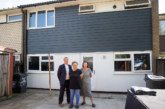The UK Green Building Council (UKGBC) has published a guide to support industry to retrofit the UK’s poorly performing commercial buildings.
From 2025, every commercial building in the UK will require an energy performance certificate (EPC) which rates its energy efficiency from grade A to G. The Government is seeking to strengthen these standards and has proposed that all commercial properties being let have a minimum EPC rating of at least ‘B’ by 2030 and is considering a possible interim requirement of level ‘C’ by 2027. Buildings which fail to meet these new standards would require owners and landlords of commercial buildings to upgrade their stock.
The drive for higher standards across commercial buildings is to address the urgent need to increase the pace at which we are retrofitting the UK’s commercial real estate. UKGBC’s analysis shows that aligning the UK built environment with the Paris Agreement will require energy consumption across commercial buildings to be reduced by 59% by 2050[1].
UKGBC’s new guide, ‘Delivering Net Zero: Key considerations for Commercial Retrofits‘, provides industry with a common approach to commercial retrofit through the lens of net zero carbon. It begins by providing much needed clarity on retrofit types such as “light retrofit” and “deep retrofit”, enabling built environment practitioners from varied backgrounds to speak with a common language and improve cross-industry communication.
It then outlines 10 fundamental considerations for low carbon focused retrofits as well as real-world case studies which exemplify these considerations, and the benefits low carbon retrofits have in the advancement towards net zero goals. The consistent approach to retrofit set out within the report provides property owners and key stakeholders with a transparent picture of the value and the benefits of opting for a net zero focused retrofit versus standard practice.
Informed by a cross-industry advisory group, the guidance highlights the actions which built environment practitioners should take to address the role existing commercial buildings play in the industry’s trajectory to net zero, and how attention must shift towards whole life carbon to successfully retrofit our existing built assets. It also demonstrates the wide-range of benefits which retrofit can deliver – beyond improved energy efficiency and reduced energy consumption – such as increased wellbeing and improved thermal comfort for occupants, reduced need for repairs and lower running costs for facilities managers and building owners.
The guide has been designed to support industry professionals and stakeholders, from architects and engineers, planners and facilities managers, to landlords and building owners, who are involved in the scoping, planning, delivery, and management of commercial retrofits with the intention of enabling successful delivery of net zero focused retrofit project outcomes. The retrofit library captures a broad range of projects of varying scales, exemplifying the established key considerations and how they can be delivered in practise.
UKGBC’s Head of Climate Action, Yetunde Abdul said: “Improving the energy efficiency of commercial buildings could slash nearly one quarter of the UK built environment’s total carbon footprint. Whilst government regulation in this space is beginning to recognise the need to improve the performance of commercial real estate, without accelerated industry action we will fail to achieve our net zero goals — both as a sector and as an economy.
“Drawing from established industry thinking and discussions with built environment professionals, this foundation setting publication has outlined key information to support and ensure the right considerations are made from beginning to end of the project to deliver net zero.”
JLL’s Head of UK Net Zero Design Consulting, David Bownass commented: “Demand for sustainable space is surging, with occupiers driving towards net zero targets and investors responding to market expectations and increasing regulation — not only to avoid ‘brown discount’ and risk of stranded assets, but increasingly acknowledging the need to act to secure a global sustainable future. Collaboration across the sector is now key to drive towards this common purpose.
“JLL estimates that, to meet global emissions standards by 2050, the rate at which we’re repurposing our commercial building stock needs to increase to around 5% annually. In the UK, this means that the pace of office redevelopment needs to at least double from levels seen over the last 10 years, while delivering a step change to achieve the 59% reduction in energy use needed by 2050.”
[1] Net Zero Whole Life Carbon Roadmap: A Pathway for the UK Built Environment. UK Green Building Council, 2021, London, UK.









